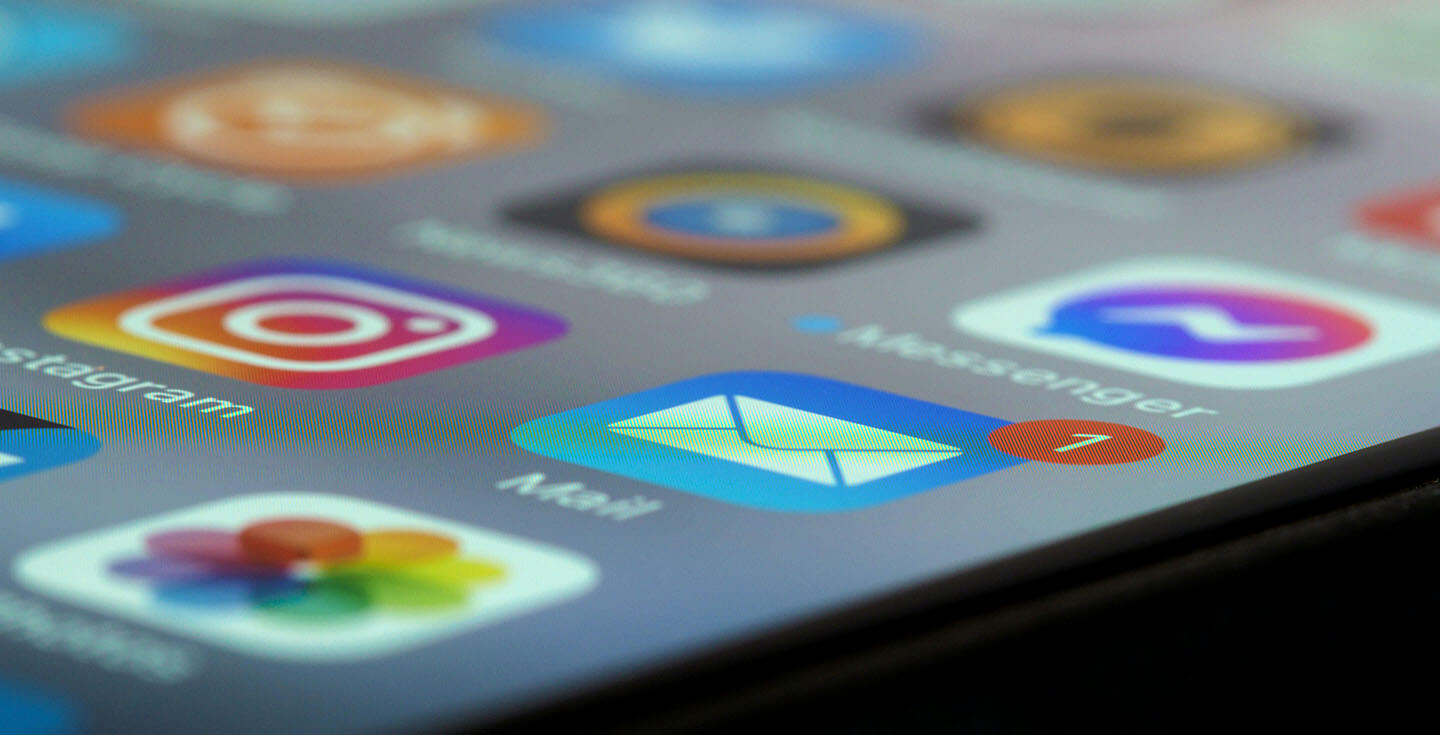The Best and Worst Tourist Cities for Mobile Internet
Some of the most beautiful destinations in the world have slow mobile internet, so it’s important to plan ahead for how you’ll stay connected
Travel is all about connection: connecting with people, places and cultures, but also to roads, train services or airport transfers.
In the 21st century, a solid mobile internet connection while traveling can help build those links with new friends and puzzling transport networks. But internet connectivity varies greatly around the world. For example, more than 200 million U.S. homes and businesses now have 5G coverage, offering speeds 100 times faster than 4G — but worldwide, only 45% of networks are equipped with the new wireless communication standard.
Some of the most beautiful and inspiring destinations in the world have very slow mobile internet, so it’s important to plan ahead for how you’ll stay connected while abroad, especially if you’re on a nomadic journey or spending extended time in your next destination. Our latest data study highlights the differences in connectivity speeds across the world’s most popular tourist cities.
In order to do this, mobile data experts at Holafly calculated the time it would take to download a 1GB map of each of the world’s most popular tourist cities using local mobile internet download speeds for each destination.
Key Findings
- Doha, Qatar, is the tourist city with the fastest mobile internet: at 354.5 Megabits per second (Mbps), it takes 2.9 seconds to download a 1GB map of the city.
- The slowest mobile internet of any popular tourist city is in Havana, Cuba, where a 4.5 Mbps connection means a download time of 229.1 seconds.
- Los Angeles is the popular North American tourist destination with the fastest mobile internet (186.6 Mbps).
- Copenhagen, Denmark, has the fastest mobile internet of any top European destination (255.9 Mbps).
Destinations in UAE, Portugal and China Have the Best Mobile Internet
Four high-profile Middle Eastern cities have the fastest mobile internet speeds of any top tourist destination globally. The Qatari capital, Doha, is the fastest of all, with average speeds of 354.5 Megabits per second (Mbps). At that rate, you can download a 1GB city map in 2.9 seconds. Doha, Dubai, Abu Dhabi and Riyadh are joined in the top ten by two Scandinavian capitals, Portugal’s two biggest cities and the major Chinese cities of Shanghai and Beijing.
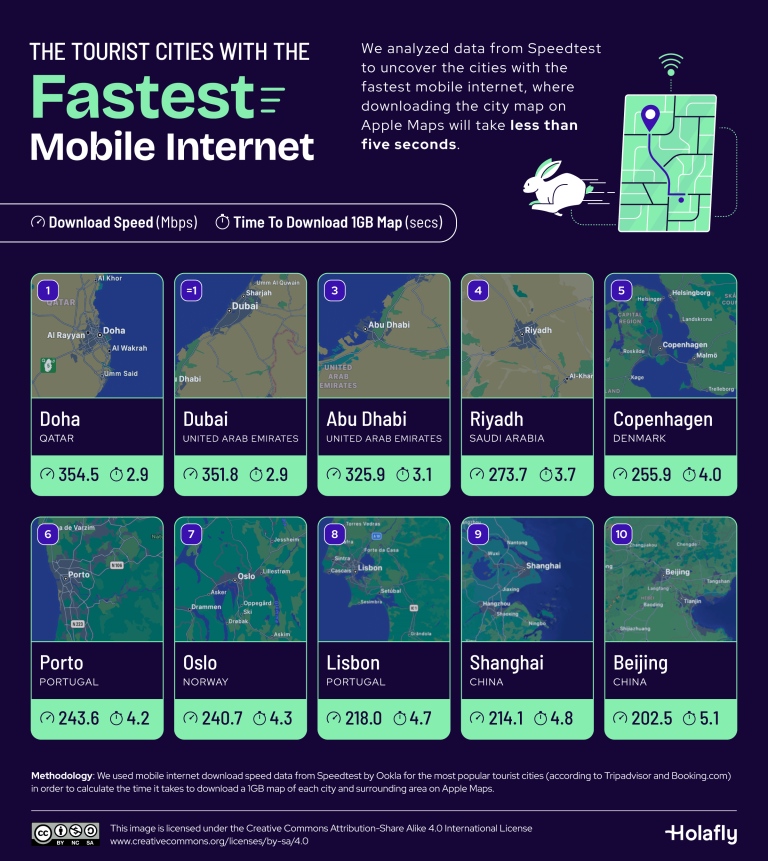
Doha’s network capabilities have been enhanced as part of a nationwide drive to establish Qatar on the international cultural and business map, as exemplified by the hosting of the 2022 World Cup and the Asian Football Confederation’s (AFC) Asian Cup.
Seven of the ten tourist cities with the slowest internet speeds are found in Latin America. The slowest, the Cuban capital of Havana, is significantly slower than the others, averaging 4.5 Mbps. At this speed, it would take nearly four minutes to download a 1GB map.

Cuba only authorized mobile internet access in 2018, and traffic volume has grown rapidly since then, with a 63% increase in usage in 2022 alone. In the meantime, economic issues have stood in the way of improving communications infrastructure. And since a state-run company monopolizes the mobile data sector, there is little competitive incentive to invest and improve. “The internet keeps getting worse and worse and we’re reaching the point where getting online is becoming impossible for the average Cuban,” local IT engineer Jorge Noris told Reuters.
Los Angeles and New York City Have the Best Internet of Top North American Cities
Two U.S. cities are among the ten North American tourist destinations with the fastest mobile internet. Los Angeles is the fastest in the region, with an 186.6 Mbps connection, allowing you to download a 1GB map in 5.5 seconds. Second-placed New York City (166.1 Mbps) also offers a network of free Wi-Fi hubs through its LinkNYC kiosks, which have replaced pay phones since 2015 and are equipped with device charging facilities.
Canada is the only North American country offering mobile internet at speeds comparable to those of the U.S. in its big tourist cities. Toronto is the third fastest North American territory in our study, with speeds of 139.7 Mbps downloading a 1GB map in 7.3 seconds.
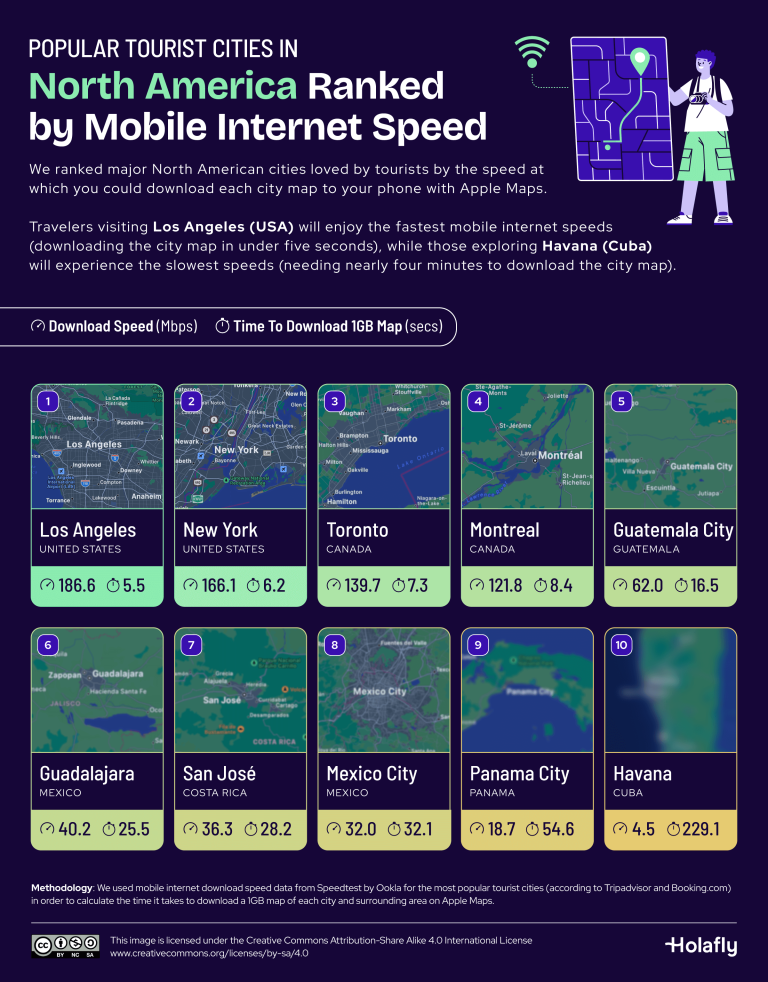
Guatemala City (62.0 Mbps) offers speeds at around half those of the top Canadian cities and one-third that of Los Angeles. New 5G coverage went live in the Guatemalan capital in 2022. Free Wi-Fi is also available via public hotspots across the country, with provider Wayfree claiming it is used by 83% of households without a home connection.
“[O]ffering Wi-Fi countrywide will result in better city planning, the possibility of implementing e-government solutions, and improved access to internet services – all of which will make the country a safer, cleaner, and “smarter” place for all,” says Enrique Cossich, Presidential Commissioner for Open and Electronic Government.
Brazil’s Biggest Cities Have Much Faster Internet Than South American Neighbors
The two biggest cities in Brazil have the fastest mobile internet of any major tourist destinations in South America — and by a significant leap. In São Paulo, the average cell data speed is 165.7 Mbps, meaning a 1GB download should take 6.2 seconds. In second-placed Rio de Janeiro, the speed is 129.3 Mbps.
Connectivity in Brazil has improved vastly since 2020, with a 69.2% broadband speed increase in the first year of the pandemic and the gradual introduction of 5G technology, and the country benefits from fierce competition between the leading mobile data suppliers.
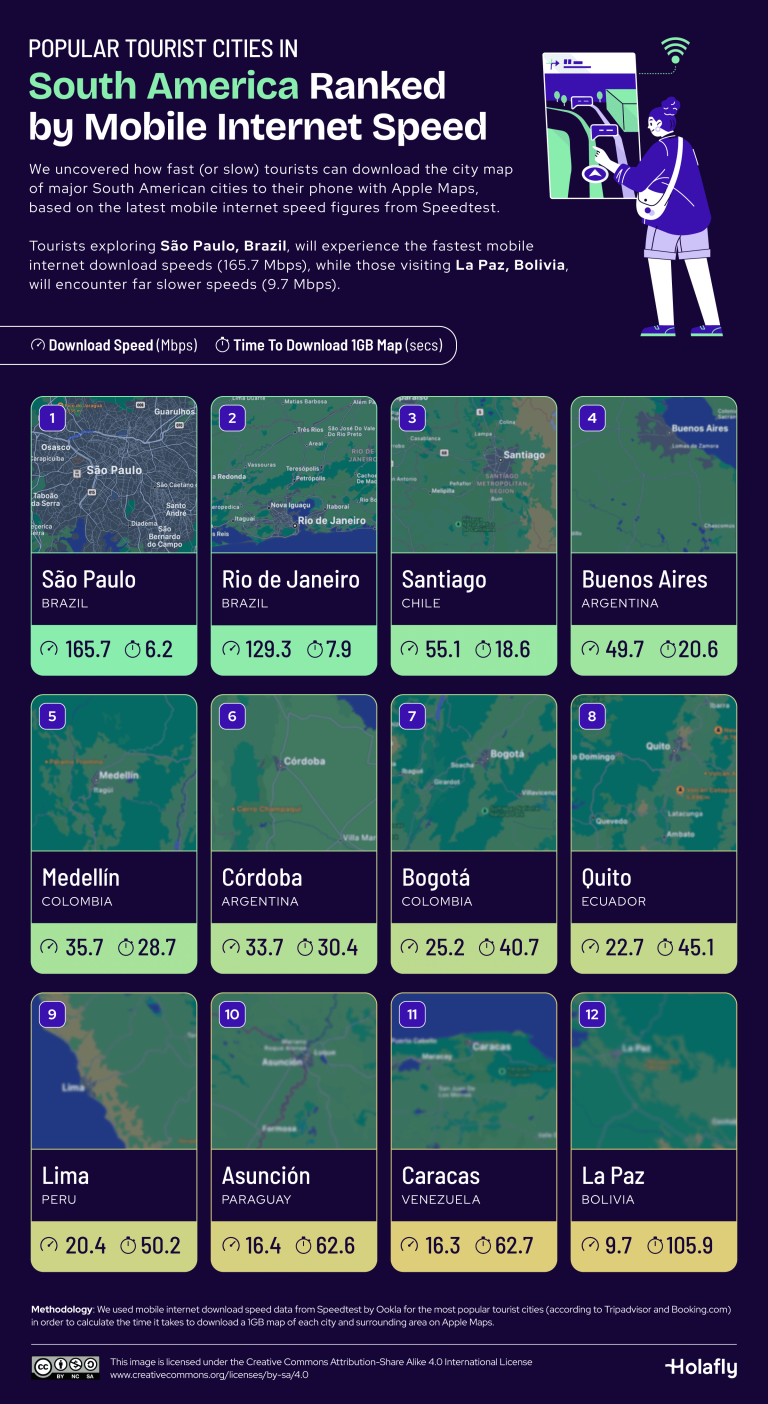
Mobile internet in second-placed Rio is 2.4 times faster than in third-placed Santiago, Chile (55.1 Mbps). However, Santiago is still 5.7 times faster than the slowest South American destination in our study, La Paz in Bolivia, where a speed of 9.7 Mbps means a 1GB download time of 105.9 seconds.
Being landlocked, Bolivia relies on cross-continental cables, and infrastructure has been slow to develop. The city has an SMS/online citizen engagement platform for digital infrastructure improvements. However, home broadband offerings remain so sketchy that the cell network still becomes overloaded with mobile data users.
Scandinavian Capitals Top European Internet Speed Charts
Europe’s five top tourist destinations for mobile internet speed are found in two areas: Scandinavia and Portugal. Copenhagen in Denmark leads a trio of Scandi capital cities. The Danish capital offers speeds of 255.9 Mbps, and it takes 4.0 seconds to download a 1GB map.
The two biggest cities in Portugal, Lisbon and Porto, offer speeds of well over 200 Mbps. Lonely Planet recently named Portugal the best country for digital nomads and remote working; some 24% of expats in Portugal rely purely on mobile data to fulfill their internet needs.
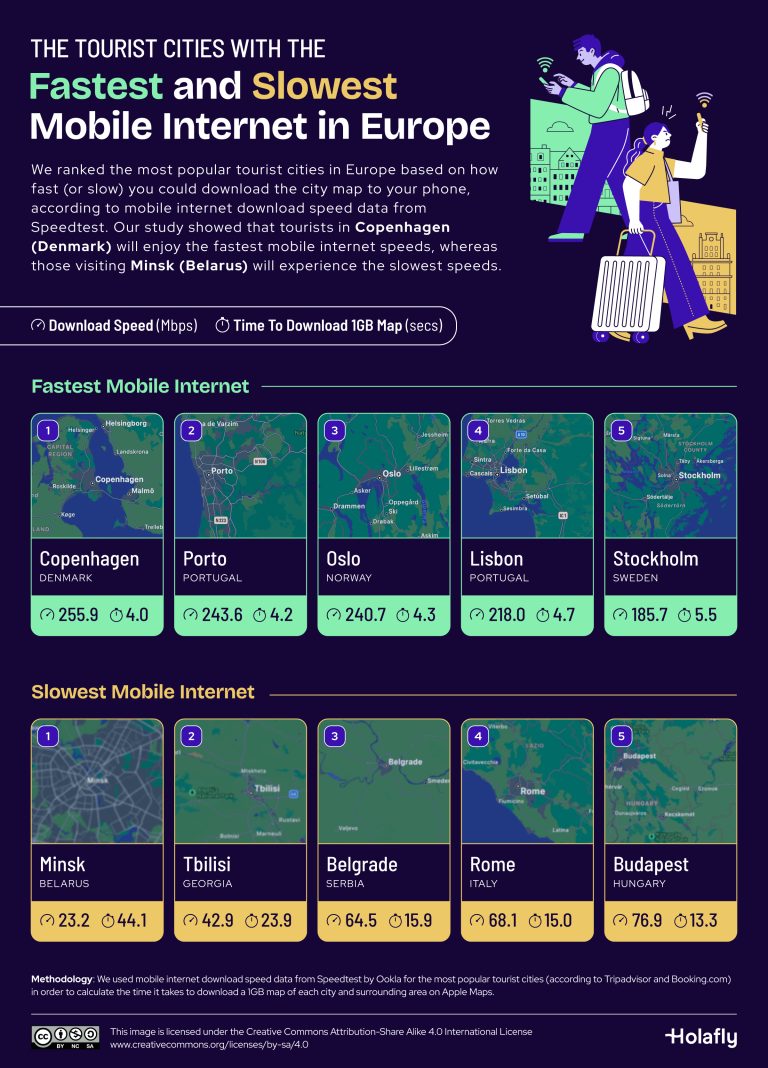
The slowest mobile internet in Europe tends towards the center and east of the continent. Minsk in Belarus has the slowest data of any major European destination city, at 23.2 Mbps, or 44.1 seconds to download 1GB. Additionally, Belarus is known to block some internationally popular websites, and the internet was switched off entirely throughout the country for nearly three days during the 2020 election.
Dubai and Shanghai Among Asia’s Fastest Connections
Four Middle-East states comprise the Asian tourist destinations with the fastest internet, led by Doha, Qatar (354.5) (see Destinations in UAE, Portugal and China Have Best Mobile Internet, above). Shanghai, China, is in fifth place, with mobile speeds of 214.1 Mbps and a 1GB download time of 4.8 seconds. China’s overall broadband speeds have reportedly increased 2.5 times in three years, and the country has 851 million 5G subscribers, according to the Ministry of Industry and Information Technology.
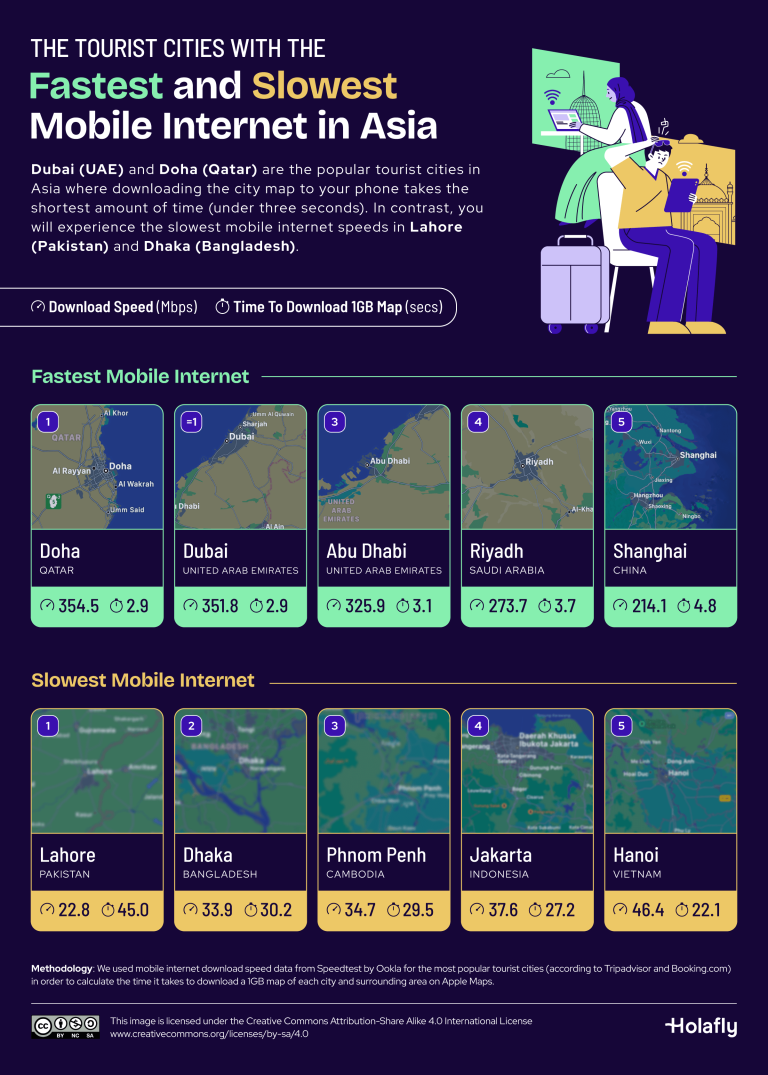
It is a different story across South and Southeast Asia, where none of the five slowest Asian cities has mobile internet speeds higher than 50 Mbps. The Pakistan capital of Lahore has the lowest speed, at 22.8 Mbps. The internet in Pakistan has been running particularly slowly since July 2024 due to faulty underwater internet cables, although the local tech community has blamed the government’s attempts to install a firewall at the national point of entry.
How to Optimize Your Mobile Experience Abroad in Low-Speed Areas
Staying connected while traveling can be challenging, especially in regions where mobile data speeds are slow. However, with careful planning and a few smart strategies, you can make the most of your internet connection without draining your data or patience. Here’s how to effectively manage your mobile experience in areas with poor connectivity:
Download Essential Content in Advance
When you know you’ll be in areas with low-speed internet, it’s wise to download important apps, maps, and documents beforehand using reliable Wi-Fi at home or a hotel. Whether it’s offline maps or your favorite shows, saving them in advance prevents you from relying on slow or unreliable signals while on the move. Always check if a location has better Wi-Fi or if the signal improves as you Travel.
- Offline Maps: Download maps from apps like Google Maps or Maps.me, which allow you to access navigation without an internet connection. This ensures you won’t be stuck waiting for directions in areas with spotty service.
Monitor App Activity and Disable Background Data
Apps that run in the background consume both data and battery life, which can be especially frustrating in low-speed areas where every bit of data counts.
- For Android: Go to Settings > Connections > Data Usage to activate Data Saver.
- For iOS: Limit background activity by going to Settings > General > Background App Refresh.
Turning off notifications and auto-sync for less essential apps can save your data for what matters most. In slow-speed areas, apps may attempt to sync or download updates repeatedly, leading to excessive background data usage, which may go unnoticed until you receive a high roaming bill. Slow speeds don’t prevent apps from using data; they just take longer, and some apps may retry multiple times to complete tasks, leading to data usage spikes.
Use an eSIM for the Best Local Connection
An international eSIM is the best solution for optimizing speed and connectivity while traveling. It will automatically connect you to the strongest network available, wherever you are. For instance, Holafly eSIM offers reliable, unlimited data at a fixed price, ensuring you stay connected without the worry of interruptions or unexpected bills worldwide due to their established partnerships with the most robust network providers in your destination.
- Crossing Borders: When you cross borders, an international eSIM simplifies your connectivity experience. You won’t need to get a different SIM card for each country, allowing you to stay connected in entire regions without changing cards. This means you can seamlessly jump into different destinations, as the eSIM will automatically connect you to the best network available for those locations. You can stay in touch with loved ones, navigate unfamiliar cities, and access important information without the hassle of managing multiple SIMs.
- Seamless Connectivity: When traveling through remote areas, network performance may fluctuate between 4G, 3G, or even slower connections. The benefit of an eSIM is its ability to maintain the highest quality connection available without manual intervention. You remain connected even in rural regions, where a regular SIM might struggle to hold a signal.
- Manual Selection: If you prefer to test which option provides the best signal, you can manually select a profile. However, the eSIM will automatically choose the optimal signal available. This feature enables you to optimize your connectivity more effectively, often delivering a stronger signal compared to local SIM cards or roaming options from your local provider.
Methodology
To rank the best and worst tourist cities for mobile internet, we compared mobile internet download speeds (www.speedtest.com) for popular tourist cities as per Booking.com’s and Tripadvisor’s rankings of the world’s most popular destinations.
For each city, we calculated the time it would take to download a 1GB map of the city and surrounding area using Apple Maps. The data was gathered in August 2024.





 Language
Language 


















 No results found
No results found






